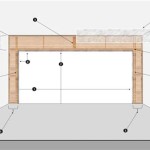Troubleshooting a Garage Door Sensor with No Light
Garage door sensors are crucial safety components of modern garage door systems. These small devices, typically located near the floor on either side of the garage door opening, are designed to prevent the door from closing if an obstruction is present in its path. They operate using an infrared beam: one sensor emits a beam, and the other receives it. When the beam is uninterrupted, the garage door opener is signaled that it is safe to close the door. A malfunctioning sensor can prevent the garage door from closing, causing inconvenience and potentially compromising the security of the garage. One common symptom of a sensor issue is the absence of light on the sensor itself, indicating a problem with its power supply, alignment, or internal components.
When one or both garage door sensors lack illumination, it signals a problem that demands investigation. This absence of light indicates the sensor is not receiving power or that an internal component has failed. The following sections provide a detailed guide to diagnosing and resolving the issue of a garage door sensor with no light, ensuring the garage door operates safely and reliably.
Examining Power Supply and Electrical Connections
The initial step in troubleshooting a garage door sensor with no light involves verifying the power supply to the sensors. These sensors typically operate on low-voltage electricity, usually supplied by the garage door opener unit itself. Start by checking the power outlet to which the garage door opener is connected. Test the outlet with another device to ensure it is providing power. If the outlet is faulty, a blown fuse or tripped circuit breaker may be the cause. Reset the circuit breaker or replace the fuse as necessary. Once the power outlet is confirmed to be functioning, move on to inspecting the wiring connecting the garage door opener to the sensors.
Carefully examine the wires running from the garage door opener to each sensor. Look for loose connections, frayed wires, or any signs of damage. Pay particular attention to the connection points at both the garage door opener and the sensors themselves. Corrosion can develop at these connection points, hindering the flow of electricity. If corrosion is present, clean the terminals with a wire brush or sandpaper to establish a good electrical contact. If wires are frayed or damaged, they should be replaced with new wiring of the same gauge and type. Ensure all wire connections are secure and properly insulated to prevent short circuits. Loose connections can cause intermittent power loss, leading to the sensor light failing to illuminate.
Garage door openers often utilize wire staples to secure the sensor wires to the garage walls or ceiling. Over time, these staples can damage the wire insulation, leading to a short circuit. Inspect the wires where they are secured by staples and ensure the insulation is intact. If damage is found, remove the staple and repair the wire with electrical tape or replace the damaged section of wire. A multimeter can be used to test the continuity of the wires. Disconnect the wires from the garage door opener and the sensors and use the multimeter to check for a complete circuit. A lack of continuity indicates a break in the wire that requires repair or replacement.
Analyzing Sensor Alignment and Obstructions
Even with a proper power supply, a garage door sensor may fail to illuminate if it is misaligned or if an obstruction is blocking the infrared beam. The sensors are designed to function only when the emitter and receiver are precisely aligned, allowing the infrared beam to travel uninterrupted between the two units. Misalignment can occur due to accidental bumping, vibrations from the garage door operation, or settling of the garage foundation. Therefore, carefully check the alignment of the sensors. Most sensors have small brackets or mounting points that allow for minor adjustments. Loosen the mounting screws slightly and gently adjust the position of the sensor until the light illuminates. Some garage door opener systems have an alignment indicator on the garage door opener unit itself that can assist with proper sensor alignment.
Examine the area between the sensors for any obstructions that may be blocking the infrared beam. Common obstructions include dust, dirt, cobwebs, or objects stored in the path of the beam. Clean the lenses of the sensors with a soft, dry cloth to remove any accumulated debris. Ensure that nothing is physically interfering with the beam's path. Even small obstructions can disrupt the signal and prevent the sensor from functioning correctly. Pay attention to the height of the sensors relative to the floor. If the floor has shifted or if objects have been placed on the floor near the sensors, the beam may be obstructed. Adjust the sensor height if necessary to ensure a clear path for the infrared beam.
Sunlight can also interfere with the operation of garage door sensors. Direct sunlight shining into the lens of the receiving sensor can overwhelm the sensor and prevent it from detecting the infrared beam. If the sensors are located in a position where they are exposed to direct sunlight, consider relocating the sensors or installing a shield to block the sunlight. In some cases, the garage door sensors may be designed with sensitivity adjustments. Check the sensor's instructions manual to see if there are any sensitivity settings that can be adjusted to compensate for sunlight interference. Proper alignment and the removal of obstructions are essential steps in ensuring the reliable operation of garage door sensors.
Investigating Internal Sensor Malfunctions
If the power supply and alignment have been verified, and there are no obstructions blocking the infrared beam, the absence of light on the garage door sensor may indicate an internal malfunction. Internal sensor malfunctions can be caused by a variety of factors, including electrical surges, component failure, or physical damage to the sensor. If the sensor has been exposed to extreme temperatures or humidity, this can also contribute to internal damage.
One method of testing for an internal malfunction is to swap the positions of the two sensors. Disconnect the wires from both sensors and reconnect them so that the receiving sensor is now acting as the emitting sensor, and vice versa. If the sensor that previously had no light now illuminates in the opposite position, this indicates that the original position has a wiring issue. If, however, the same sensor continues to have no light regardless of its position, this suggests that the sensor itself is faulty and needs to be replaced. Before replacing the sensor, consult the garage door opener's manual or the sensor's documentation for any diagnostic procedures or troubleshooting steps specific to that model. Some sensors have internal fuses or other resettable components that may be the cause of the problem.
When replacing a garage door sensor, ensure that the replacement sensor is compatible with the garage door opener. Using an incompatible sensor can result in improper operation or damage to the garage door opener system. Follow the manufacturer's instructions for installing the new sensor. This often involves disconnecting the power to the garage door opener, removing the old sensor, and connecting the wires to the new sensor. Secure the new sensor in place, ensuring that it is properly aligned with the corresponding sensor on the opposite side of the garage door opening. After installing the new sensor, test the operation of the garage door to verify that the sensors are functioning correctly. If the garage door still fails to operate properly after replacing the sensor, further troubleshooting may be required, potentially involving the garage door opener unit itself.

Garage Door Remote Not Working A Plus Doors

Garage Door Safety Sensors Out Of Alignment Easy Fix

Garage Door Sensor Melbourne 24 Hour Install Fix Upgrade

Fix Garage Door Sensor Lights Why The Light Is Flashing Youtube

Garage Door Won T Close And Light Flashes How To Fix Easy

Garage Door Won T Close How To Align Safety Reverse Sensors Fast Easy

Genie Garage Door Opener Not Closing Easy Fix

New Chamberlain Garage Door Opener Will Not Open Flashes 2 Times

Yellow Light On Garage Door Sensor Quick And Easy Fix

Garage Door Safety Sensors Troubleshooting Complete 3 Step Guide








